
Salkeld Hall is a red sandstone Grade II* listed country house in the village of Little Salkeld, Cumbria, England and is the original residence of the Salkeld family.

Salkeld Hall is a red sandstone Grade II* listed country house in the village of Little Salkeld, Cumbria, England and is the original residence of the Salkeld family.
The current house was constructed in the late 16th century using walls from previous building(s) that stood on the site. The oldest part of the building was dated in 1967 as being from the 14th century. [1] The date of the first building to exist on the site is unknown; it is the potential location of an 'ancient castle'. [2]
Corby Castle in nearby Great Corby, built from similar materials in the 14th century, was also owned by the Salkeld Family. Mr George Salkeld, the last member of which to own Salkeld Hall, was forced from the house at the time of the English Civil War for a 'trifling consideration'. Ownership was passed to Colonel Cholmley, who built a new house on the site, and before the year of 1688 it became the property of Mr Charles Smallwood. His descendant, Timothy Smallwood, Esq. sold the house to Colonel Samuel Lacy in 1790. [2]
During his occupation of the house Lacy's servant (a deserted batman) was (under instruction) responsible for the carving of Lacy's Caves and allegedly attempting to blow up the stones at the nearby Long Meg and Her Daughters stone circle with gunpowder so that the field could be ploughed. The latter is unconfirmed and according to some sources took place in 1725 before Lacy was alive. Local folklore tells that when work commenced a tremendous storm broke out overhead that caused the workmen to flee the site and abandon the work permanently. The stones seem to show no sign of such an explosion.
Colonel Lacy sold the house in 1836 to Robert Hodgson, Esq. Ownership between this and the current is unknown, however in 1847 Robert Hodgson was still the reported owner and had made great improvements to the house, offices and gardens. [3]
In 1967 the house was recorded as having been divided into a number of holiday flats.
The house is currently privately owned with no public rights of way across the land. The main part of the house is intact and occupied by the owner. What were holiday flats are now rented on a contract basis, and little modernisation has taken place since the 1960s. A number of outbuildings to the south-east of the property, which at one time would have been self-contained two-storey houses, are now in ruins.

Peel towers are small fortified keeps or tower houses, built along the English and Scottish borders in the Scottish Marches and North of England, mainly between the mid-14th century and about 1600. They were free-standing with defence being a prime consideration of their design with "confirmation of status and prestige" also playing a role. They also functioned as watch towers where signal fires could be lit by the garrison to warn of approaching danger.
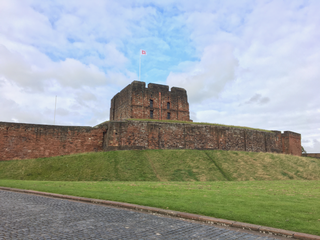
Carlisle Castle is a stone keep medieval fortress located in the city of Carlisle near the ruins of Hadrian's Wall. First built during the reign of William II in 1092 and rebuilt in stone under Henry I in 1122, the castle is over 930 years old and has been the scene of many episodes in British history.

Penrith Castle is a now-ruined medieval castle located in Penrith, in the north-west of England, a few miles to the east of the Lake District National Park.

Muncaster Castle is a privately owned castle overlooking the River Esk, about a mile east of the west-coastal town of Ravenglass in Cumbria, England. It is recorded in the National Heritage List for England as a designated Grade I listed building.

Inglewood Forest is a large tract of mainly arable and dairy farm land with a few small woodland areas between Carlisle and Penrith in the English non-metropolitan county of Cumbria or ancient county of Cumberland.
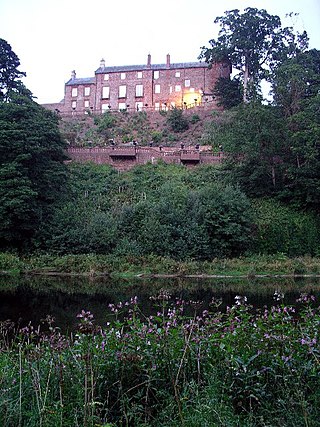
Corby Castle is a Grade I listed building and ancestral home of the Howard family situated on the southern edge of the village of Great Corby in northern Cumbria, England.

Brougham Castle is a medieval building about 2 miles (3.2 km) south-east of Penrith, Cumbria, England. The castle was founded by Robert I de Vieuxpont in the early 13th century. The site, near the confluence of the rivers Eamont and Lowther, had been chosen by the Romans for a Roman fort called Brocavum. The castle, along with the fort, is a scheduled monument: "Brougham Roman fort and Brougham Castle".

Appleby Castle is in the town of Appleby-in-Westmorland overlooking the River Eden. It consists of a 12th-century castle keep which is known as Caesar's Tower, and a mansion house. These, together with their associated buildings, are set in a courtyard surrounded by curtain walls. Caesar's Tower and the mansion house are each recorded in the National Heritage List for England as a designated Grade I listed building. The uninhabited parts of the castle are a scheduled ancient monument.

Armathwaite Castle is in the village of Armathwaite, Cumbria, England, by the River Eden. Originally built to defend against Scottish raiders in the 15th century, it was converted into a mansion and today is a Grade II* listed building.

Little Salkeld is a small village and former civil parish, now in the parish of Hunsonby, in the Eden district of Cumbria, England, a few miles to the north east of Penrith. In 1931 the civil parish had a population of 91.

Lacy's Caves are a series of five chambers in the red sandstone cliff of the River Eden, just north of Little Salkeld, Cumbria, England, near Nunnery, Cumbria, at grid reference NY564383.

Greystoke Castle is in the village of Greystoke 8 kilometres (5.0 mi) west of Penrith in the county of Cumbria in northern England.. It is owned by the Howard family and is a private residence including a castle and family estate with no public access.

Edenhall is a clustered village and former civil parish, now in the south-west of the parish of Langwathby, 800m to the north in the Westmorland and Furness district, in Cumbria, England. Edenhall has a church called St Cuthbert's Church. The name Edenhall originates from Eden Hall house, the seat of the Musgrave family of Hartley Castle, Cumberland many of whom were members of the House of Commons. In 1931 the civil parish had a population of 216. On 1 April 1934 the civil parish was merged into Langwathby.

Keisley is a small hamlet in the English county of Cumbria. It is located in the Dufton civil parish and the Eden district.
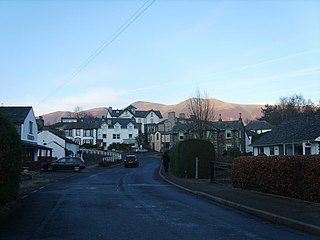
Portinscale is a village in Cumbria, England, close to the western shore of Derwentwater in the Lake District National Park 1+1⁄2 miles from Keswick.
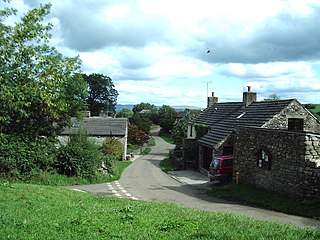
Waitby is a small village and civil parish in the Eden district of Cumbria, England. The parish contains two small villages, Waitby and Smardale, plus the small hamlets of Riddlesay, Stripes and Leases, all of which are in the farmed and enclosured northern part at an elevation of around 200–300m. The southern half of the parish is mostly heath and unused for agriculture, it rises to Smardale fell; which it includes, at elevations between 300 and 400m. The civil parish of Ravenstonedale forms the boundary to the south. The western border with Crosby Garrett civil parish is formed by Scandal Beck. To the north and east lie Soulby and Kirkby Stephen civil parishes respectively. The population of the civil parish as measured at the 2011 Census was less than 100. Details are included in the parish of Crosby Garrett.
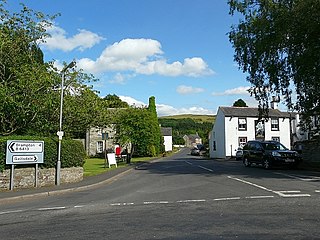
Castle Carrock is a village and civil parish on the B6413 road, in the Cumberland District, in the English county of Cumbria about 3 miles (4.8 km) south of Brampton. The population of the Civil Parish was 303 in 2001 and rose to 328 by 2011. It has a pub, The Duke of Cumberland, a primary school and many walks. More recently Castle Carrock is known for 'Cumbria's Most Friendly Music Festival' Music on the Marr which takes place each year at the end of July. It attracts a diverse crop of music, entertainers, artists and poets from around the world.

Scaleby Castle is in the village of Scaleby, Cumbria, England. The castle was originally built in the early 14th century, and extended in the 15th century to form a substantial fortification. Parliamentary troops attacked the castle twice during the English Civil War, burning it. It was later restored to form a country house.

Millom Castle is an ancient building at Millom in Cumbria. It is a Grade I listed building and scheduled ancient monument.

Calthwaite Hall, near Penrith in Cumbria, England, is a house of historical significance and is Grade II listed on the National Heritage List for England. It was built in 1837 for Thomas Dixon Esq and was the home of many notable people for the next 150 years. It is now a venue for weddings and other special events and also provides accommodation.